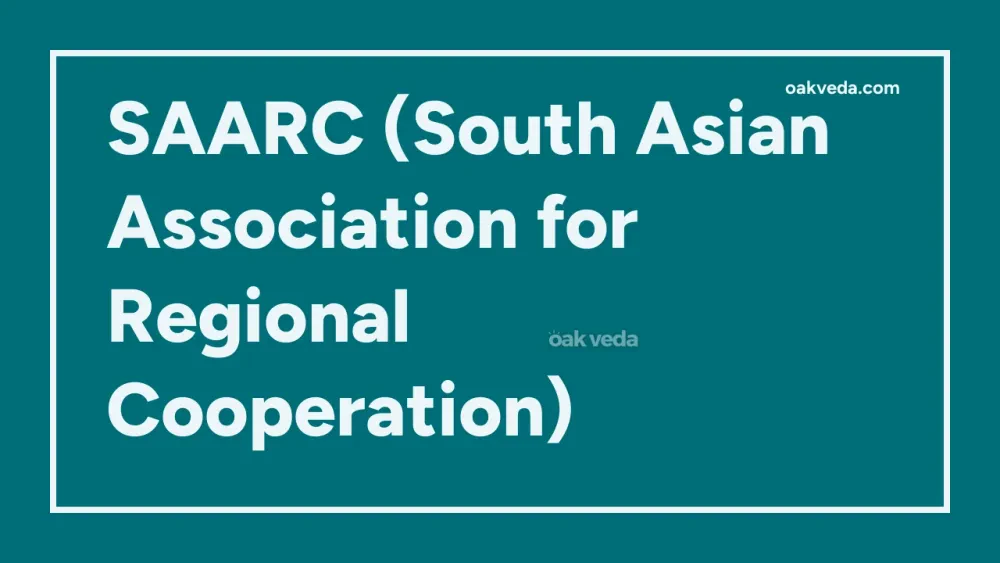
What is the Full Form of SAARC?
SAARC is the acronym for the South Asian Association for Regional Cooperation. This intergovernmental organization and geopolitical union of nations in South Asia was established to promote collaboration and improve the quality of life for the people in the region.
What is South Asian Association for Regional Cooperation?
The South Asian Association for Regional Cooperation (SAARC) is a regional intergovernmental organization and geopolitical union of nations in South Asia. Founded in 1985, SAARC aims to promote active collaboration and mutual assistance in various fields, including economic, social, cultural, technical, and scientific.
Origin and Development of SAARC
The idea of SAARC was first proposed by the President of Bangladesh, Ziaur Rahman, in 1980. The concept gained traction, and after several years of consultation, SAARC was officially established on December 8, 1985, with the signing of its charter in Dhaka, Bangladesh.
Initially, SAARC consisted of seven member states:
- Bangladesh
- Bhutan
- India
- Maldives
- Nepal
- Pakistan
- Sri Lanka
In 2007, Afghanistan joined as the eighth member, expanding the organization's reach and influence in the region.
How does SAARC work?
SAARC operates through several mechanisms:
-
Summit Meetings: Heads of State or Government meet annually to discuss regional issues and set the organization's agenda.
-
Council of Ministers: Foreign ministers of member countries meet twice a year to formulate policies and review progress.
-
Standing Committee: Foreign secretaries meet as often as deemed necessary to monitor and coordinate programs.
-
Technical Committees: Experts from member countries work on specific areas of cooperation.
-
Secretariat: Located in Kathmandu, Nepal, it coordinates SAARC activities and implements decisions.
Functions of SAARC
SAARC's primary functions include:
- Promoting the welfare of the people of South Asia
- Accelerating economic growth and social progress in the region
- Promoting active collaboration in various fields
- Strengthening cooperation among member states in international forums on matters of common interest
- Cooperating with international and regional organizations with similar aims and purposes
Applications of SAARC
SAARC has several practical applications in fostering regional cooperation:
-
Economic Cooperation: Promoting trade and investment within the region through initiatives like the South Asian Free Trade Area (SAFTA).
-
Cultural Exchange: Facilitating cultural interactions and understanding among member nations.
-
Disaster Management: Coordinating efforts for disaster preparedness and response in the region.
-
Education: Promoting educational exchanges and cooperation in higher education.
-
Health: Collaborating on health issues, including pandemic response and medical research.
Features of SAARC
Key features of SAARC include:
- Geographical Focus: Concentrates on South Asian countries
- Consensus-based Decision Making: Decisions are made by unanimity
- Non-interference: Bilateral and contentious issues are excluded from deliberations
- Regular Summits: Annual meetings of heads of state or government
- Observer States: Includes countries like China, USA, and EU as observers
Benefits of SAARC
SAARC offers several benefits to its member states:
- Economic Integration: Facilitates increased trade and economic cooperation
- Regional Stability: Promotes peace and stability through dialogue and cooperation
- Cultural Exchange: Enhances mutual understanding and cultural ties
- Collective Bargaining Power: Strengthens the region's position in global affairs
- Shared Resources: Enables sharing of knowledge, technology, and resources
Limitations or Challenges of SAARC
Despite its potential, SAARC faces several challenges:
- Political Tensions: Bilateral issues, particularly between India and Pakistan, often hinder progress
- Economic Disparities: Significant economic differences among member states complicate integration efforts
- Limited Intra-regional Trade: Trade within SAARC countries remains low compared to other regional blocs
- Implementation Issues: Slow implementation of agreements and initiatives
- Lack of Trust: Historical conflicts and suspicions sometimes impede cooperation
Future Developments in SAARC
The future of SAARC depends on overcoming its challenges and capitalizing on emerging opportunities:
- Digital Cooperation: Enhancing collaboration in digital technologies and e-commerce
- Climate Change Initiatives: Joint efforts to address environmental challenges
- Strengthening SAFTA: Further reducing trade barriers and promoting intra-regional trade
- People-to-People Contact: Increasing cultural exchanges and tourism within the region
- Health Cooperation: Building on lessons from the COVID-19 pandemic to improve regional health systems
FAQs on SAARC Full Form
-
What is the full form of SAARC? The full form of SAARC is South Asian Association for Regional Cooperation.
-
How many countries are members of SAARC? SAARC has eight member countries: Afghanistan, Bangladesh, Bhutan, India, Maldives, Nepal, Pakistan, and Sri Lanka.
-
When was SAARC established? SAARC was officially established on December 8, 1985.
-
Where is the SAARC Secretariat located? The SAARC Secretariat is located in Kathmandu, Nepal.
-
What is the main objective of SAARC? The main objective of SAARC is to promote active collaboration and mutual assistance in various fields among South Asian countries.
In conclusion, SAARC, with its full form being the South Asian Association for Regional Cooperation, plays a crucial role in fostering collaboration and development in South Asia. Despite facing challenges, it continues to be an important platform for regional dialogue and cooperation, with the potential to significantly impact the lives of nearly two billion people in the region.
You may be interested in:

